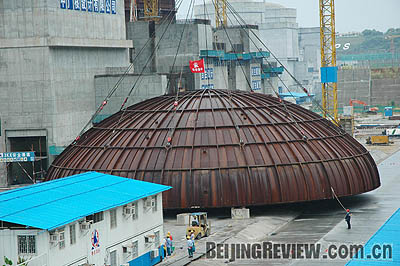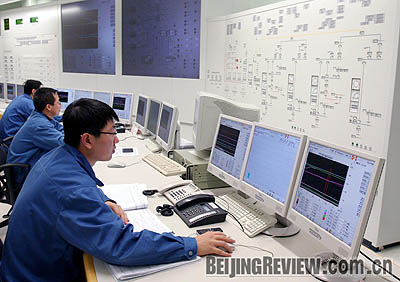|

NUCLEAR SHELL: Phase 2 of the Ling’ao Nuclear Power Plant is under construction in Guangdong Province
Almost 30 years ago, a partial core meltdown occurred in one of the two nuclear reactors at Three Mile Island Nuclear Generating Station in the U.S. state of Pennsylvania-the worst commercial nuclear accident in American history. Although none of the plant's workers or residents in the surrounding communities lost their lives or suffered injuries, the accident resulted in a complete cessation of nuclear reactor construction in the United States. No nuclear power plants have been built in the United States since then.
But now, engineers from the United States are working with their Chinese partners on the construction of China's first nuclear power plants using AP1000 technology developed by Westinghouse Electric Co. LLC of Pittsburgh, Pennsylvania. AP1000 is an advanced nuclear power technology based on standard pressurized water reactor technology, but costs less to build and maintain. Reactors constructed with the technology are easier to operate and have safety features that minimize the likelihood of human errors and other failures.
The collaboration between the Chinese and Americans began in December 2006, when the two countries signed a memorandum on the introduction and transfer of third-generation nuclear power technologies. In May 2007, the Chinese Government established the State Nuclear Power Technology Corp. (SNPTC) in Beijing to develop the country's own brand-name nuclear power technology through the development, application and innovation of third-generation nuclear power technology. On February 26 and July 29, 2008, two nuclear power self-reliance programs started excavation in Sanmen, Zhejiang Province, and Haiyang, Shandong Province, respectively.
According to China Youth Daily report, the Joint Project Management Organization (JMPO) that is working on the projects consists of personnel from Westinghouse, SNPTC and program owners, who represent SNPTC and are managing the construction of the AP1000 reactors. Dozens of young engineers from the Shanghai Nuclear Engineering Research and Design Institute and the State Nuclear Power Engineering Corp. Ltd. are working at Westinghouse with American experts, drawing up detailed blueprints for the construction of AP1000 reactors. All in all, about 300 Chinese engineers will work at Westinghouse for three years.
Nuclear development
In the coastal areas of Sanmen and Haiyang, the excavation projects that extend dozens of meters into the ground illustrate the huge scopes of the power plant projects. On August 22, the excavation project at the No.1 unit of the Sanmen Nuclear Power Plant passed a check by experts from the State Nuclear Safety Administration. Construction is expected to start in March 2009.
"Here will not only see the establishment of the world's first AP1000 unit in 2013, but also will be the nuclear power base of the third generation in the world," said Gu Jun, General Manager of the Sanmen Nuclear Power Co. who has worked in the nuclear power industry for more than 20 years and previously served as a senior operator in the main control room at the Qinshan Nuclear Power Plant in Zhejiang Province. Gu told China Youth Daily that during the last two decades he has seen nuclear plants make gradual progress from using second-generation technology-light and heavy water reactors-to third-generation technology.
According to China Youth Daily report, late Premier Zhou Enlai showed great foresight in 1970 after he heard a report about electricity shortages in Shanghai and determined that the country needed to develop nuclear power facilities to solve electricity shortages in east China in the years to come because of oil and coal shortages.

MONITORING THE FLOW: Operators at work at the Tianwan Nuclear Power Plant in Jiangsu Province
Qinshan Nuclear Power Plant, China's first independently designed and constructed nuclear power plant, started construction in 1985 and was completed on December 15, 1991. Since that time, five more nuclear power
| 